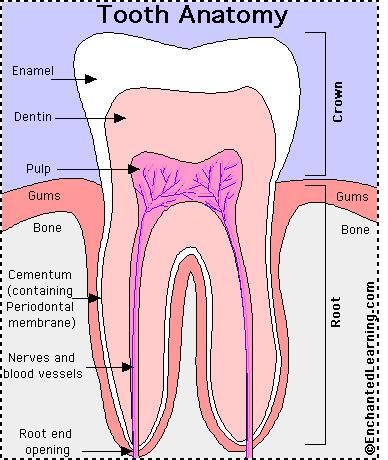Up to 70% of all cats and dogs have periodontal disease, making it the most common health condition affecting our animals. Yet it remains one of the most over-looked areas in the health care of pets. Periodontal disease is the inflammation and infection of the structures that support the teeth – the gums, periodontal ligament, alveolar bone, and tooth roots. People recognize that maintaining good oral health plays a role in our overall well-being, and, just as with other organ systems, finding dental problems early can often mean slowing or even stopping the progression of disease. Mounting evidence in veterinary medicine suggests a link between the health of teeth and gums and the overall health of pets, such as an association between advanced periodontal disease and microscopic changes within the heart, kidneys, and liver. Whether your goal is to focus on preventative medicine and enhance your pets’ overall well-being, or you just can’t take that doggy breath any more, the importance of dental care is being recognized more and more.
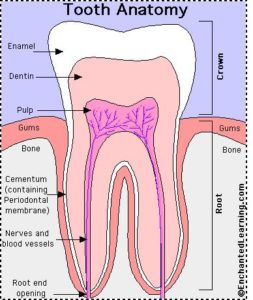
Dental disease is painful! Many owners are skeptical when informed that their animal has a painful oral condition such as gingivitis, root exposure, or fractured teeth. They see that their pet is still eating, and perhaps even playing with toys as if nothing is wrong. This common misconception stems from the fact that evolution has trained animals to hide their pain, and some dogs with a very high drive to play with a certain toy will continue to do so despite the pain (similar to many humans that continue with their favourite activity – running, tennis – despite injury). Animals do not want to starve, so they continue to eat. Sometimes under closer inspection, it becomes evident that they are avoiding chewing on the side of the mouth causing pain. Studies have shown that dogs and cats have similar pain tolerances and thresholds as humans, so it is safe to assume that a condition that would be painful in your mouth is also causing your pet pain. If you fractured your tooth today you would not be reading this article – you would be at the dentist office or emergency room seeking relief.
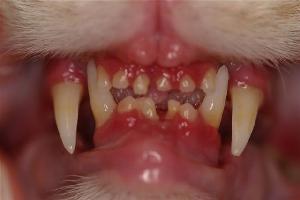
This kitty has severe gingivitis and periodontal disease. Periodontal disease is a reaction to bacteria within the tissues surrounding the tooth. You can see the gingival inflammation and gum recession. The loss of alveolar bone (the bone the tooth root is anchored in) has exposed the roots of the lower central incisors. This is a painful condition for this cat.
In some cases, owners are unaware that their pet has dental disease. The problem may be identified with a routine physical exam or during investigation of another problem. In other situations disease is apparent in the form of very bad breath, difficulty eating, drooling, or changes in temperament. Diagnosis of dental disease is usually very straightforward. A visual examination of the oral cavity reveals tartar and gingivitis, fractures, or other problems. However, the true extent of the disease cannot be determined until the animal is under anaesthesia to allow for a complete examination of the oral cavity including dental radiographs. Because two-thirds of the tooth is below the gingiva or gum line, it is not possible to fully assess the tooth without a dental x-ray. It makes no sense to place an animal under anaesthesia to clean teeth and miss an important problem by not taking dental x-rays.
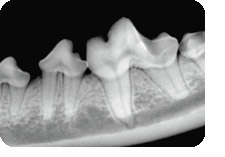
This radiograph shows healthy teeth with good alveolar bone density around the tooth roots.
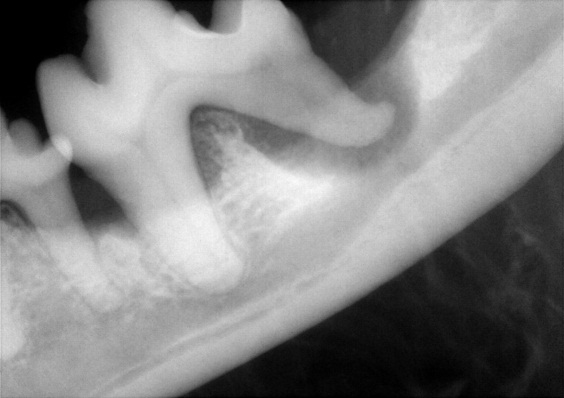
This radiograph shows bone loss between the two teeth, as well as an abscess at the tip of the root. This is a tooth that needs to be extracted.
Our goal is to prevent dental disease before it has a chance to set up long-term infection. There are many things that owners can do at home:
- Circle small, gums and all… Brush my pet’s teeth?! Yes, this is the “Gold Standard” of home tooth care. It is the most effective means of controlling plaque and periodontal disease in your pet.
- Start young. The sooner you start your pet on oral health care, the easier it will be to do. But even grown dogs (and cats) can learn to tolerate brushing.
- Go slowly. Start with just handling the mouth for a short period, then gently lift the lips and massage the gums. Finally, introduce the brush.
- Make it positive. Try to link this activity to positive rewards.
- Tools: A soft child’s toothbrush works well. There is a small, circular ended brush for cats that you can get from your veterinarian. There are a variety of pet toothpastes available. DO NOT use regular human toothpaste as it can be irritating to your pet’s stomach and flouride is toxic when swallowed..
- Frequency: Once a day would be ideal as plaque is formed within 24 hours, however this is not always possible. If you brush your pet’s teeth a minimum of 3 times per week you can reduce plaque by 75%.
- Technique: There are helpful videos to refer to on-line. Brush all the teeth in succession with a small circular motion and a small amount of veterinary toothpaste. For the rear teeth, you can usually just place the brush in under the lips. The rear lower teeth and the insides of the teeth are trickier to get. If your pet does not tolerate you slightly opening the mouth to get these areas then don’t worry as most periodontal disease occurs on the outside of the teeth.
- Tartar Control Diets. There are numerous tartar control diets available that will help clean the teeth. The one we recommend most often is Hills t/d, as it is very effective at preventing periodontal disease. It is only available through your veterinarian. It comes in a cat form, as well as two sizes for dogs. This is balanced enough to be the sole food for your pet (as long as there are no other health issues that require a special diet). In addition, there are various tartar control chews and biscuits that have varying levels of effectiveness.
- Enzymatic rinses and additives
- There are products available to use as a disinfectant rinse for your pets mouth, or an enzymatic additive for your pets water to help decrease bacteria and minimize plaque development.
- Dental Chew Toys. The mechanical action of chewing can help remove tartar from teeth. Avoid natural bones, dried cow hooves and hard nylon toys as these are hard enough to fracture teeth. We recommend C.E.T. Chews.
- Routine Examination of your Pets Mouth. The best way to know what’s happening in your pet’s mouth is to get in there and have a look. Any abnormalities should be brought to the attention of your veterinarian.
Here are some helpful links:
Dr. Fraser Hale, Veterinary Dentist Specialist, has a lot of information on his website The Tooth Vet including the following links:
Dental Home Care for Cats and Dogs
Dr. Andrea Wernham
Hillcrest Animal Hospital
January, 2012


